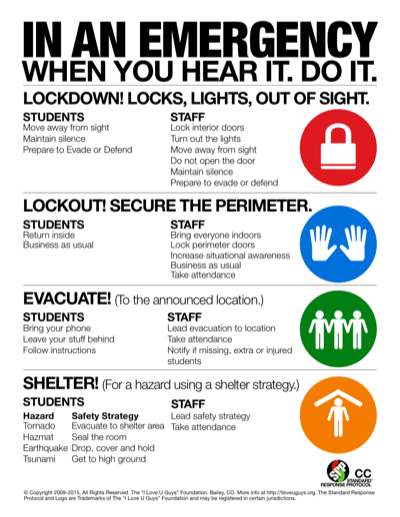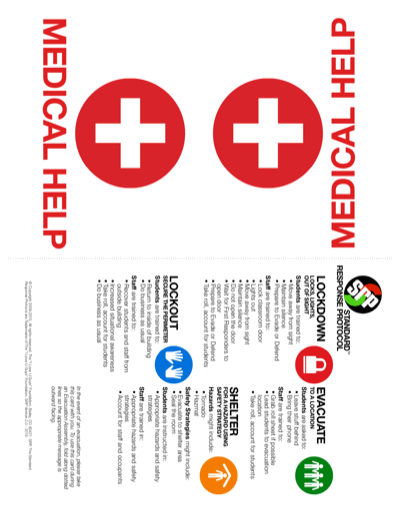A critical ingredient in the safe campus recipe is the uniform response to an incident on campus. Weather events, fires, accidents, intruders and other threats to student and staff safety are scenarios that are planned and trained for by campus administration.
Historically, colleges have taken a scenario-based approach to respond to hazards and threats. It's not uncommon to find a stapled sheaf of papers or even a tabbed binder in a instructor's desk that describes a variety of things that might happen and the specific response to each event.
This version of our flagship program, the Standard Response Protocol (SRP) provides actions more akin to what can be expected of adult students.
The Standard Response Protocol (SRP) is based not on individual scenarios but on the response to any given situation. Like the Incident Command System (ICS), SRP demands a specific vocabulary but also allows for great flexibility. The premise is simple - there are four specific actions that can be performed during an incident. When communicating these, the action is labeled with a "Term of Art" and is then followed by a "Directive." Execution of the action is performed by active participants, including students, staff, teachers and first responders.
These specific actions can act as both a verb and a noun. If the action is Lockdown, it would be announced on public address as "Lockdown! Locks, Lights, Out of Sight." Communication to local Law Enforcement Agency would then be "We are under Lockdown." Each response has specific student and staff action. The Evacuate response is always followed by a location: "Evacuate to the Bus Zone." Responses can also be combined: "Evacuate to Hallway; Shelter for Tornado; Drop, Cover and Hold."
The benefits of SRP become quickly apparent. By standardizing the vocabulary, all stakeholders can understand the response and status of the event. For students, this provides continuity of expectations and actions throughout their educational career. For staff and professors, this becomes a simpler process to train and drill. For first responders, the common vocabulary and protocols establish a greater predictability that persists through the duration of an incident. Additionally, this protocol enables rapid response determination when an unforeseen event occurs.
The protocol also allows for a more predictable series of actions as an event unfolds. An intruder event may start as a Lockdown, but as the intruder is isolated, first responders might transition parts of the school to an "Evacuate to the Gym and Lockdown," and later "Evacuate to the Bus Zone."
The differentiation between Lockout and Lockdown is a critical element in SRP. A Lockout recovers all students from outside the building, secures the building perimeter and locks all outside doors. This would be implemented when there is a threat or hazard outside of the building. Criminal activity, dangerous events in the community, or even a vicious dog on the playground would be examples of a Lockout response. While the Lockout response encourages greater staff situational awareness, it allows for educational practices to continue with little classroom interruption or distraction.
Lockdown is a classroom-based protocol that requires locking the classroom door, turning off the lights and placing students out of sight of any corridor windows. Student action during Lockdown is to remain quiet. It does not mandate locking outside doors. There are several reasons for not locking perimeter doors during a Lockdown. Risk is increased to students or staff in exposed areas attempting to lock outside doors. Locking outside doors inhibits entry of first responders and increases risk as responders attempt to breach doors.
There may be situations where both Lockdown and Lockout need to be performed, but in this case they are identified individually. "Lockout! Get Inside. Lockdown! Locks, Lights, out of Sight." would be announced on public address. We are in "Lockdown and Lockout" would be conveyed to emergency services or 911.
SRP also acknowledges that some incidents involve a tactical response from law enforcement, and suggests consulting with local law enforcement for specific simple actions in that event.
Downloadable versions of all materials are made available at no cost.
Optionally, you can purchase printed materials.
 SRP CC Poster
SRP CC Poster
The classroom poster gives students and staff a quick reference of the SRP terms and actions.
 SRP CC - Red Card/Green Card
SRP CC - Red Card/Green Card
We offer three different versions of the cards. Choose the one that fits your needs.
In partnership with the Koshka Foundation and the Columbine: Wounded Minds Project, The "I Love U Guys" Foundation has produced a training video targeting community college students. It is recommended that this video be part of an in-person student orientation or required viewing on the campus student web site.
Download the Video
This 3.5 day Symposium examines lessons learned from traumatic events and reveals new, preemptive school safety measures growing in multiple realms. The Symposium is designed to provide a number of takeaways that districts, departments and agencies can implement immediately. This is not open to the public, and attendees will be asked to show an agency or organization I.D. upon check-in.
Law enforcement, school personnel, victim advocates, mental health professionals, emergency and risk management staff, school safety teams and all first responders.
Presenters include school administrators, law enforcement, criminal justice and school security administrators who have been involved in the response and recovery to school violence and other events.
Find Out MoreIt does not mean to be in a place where there is no noise, trouble, or hard work.
It means to be in the midst of those things and still be calm in your heart.